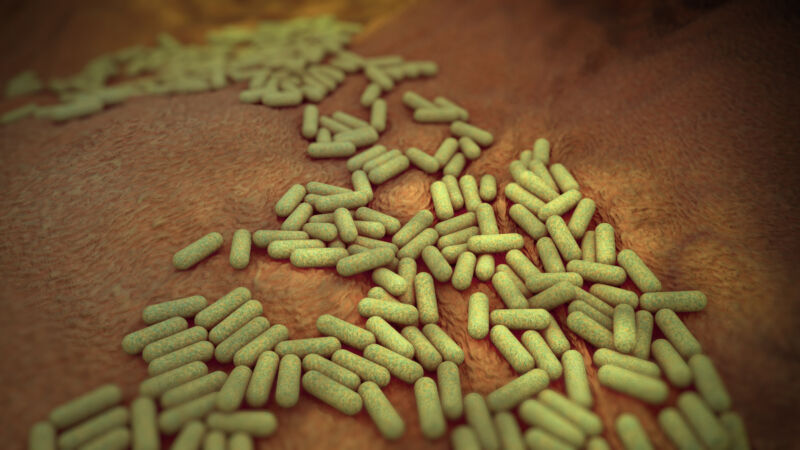
Cellulose is the primary component of the cell walls of plants, making it the most common polymer on Earth. It’s responsible for the properties of materials like wood and cotton and is the primary component of dietary fiber, so it’s hard to overstate its importance to humanity.
Given its ubiquity and the fact that it’s composed of a bunch of sugar molecules linked together, its toughness makes it very difficult to use as a food source. The animals that manage to extract significant calories from cellulose typically do so via specialized digestive tracts that provide a home for symbiotic bacteria—think of the extra stomachs of cows and other ruminants.
Amazingly, humans also play host to bacteria that can break down cellulose—something that wasn’t confirmed until 2003 (long after I’d wrapped up my education). Now, a new study indicates that we’re host to a mix of cellulose-eating bacteria, some via our primate ancestry, and others through our domestication of herbivores such as cows. But urban living has caused the number of these bacteria to shrink dramatically.
Finding the plant eaters
While cellulose-eating bacteria that make humans their home were found back in 2003, only a single species from this group has been identified since. The work here, done by a large international collaboration, focused on getting a more complete picture of what’s living in our guts. To do so, they obtained gut samples from humans and ruminants. These were used to obtain DNA from the bacteria that live there, which were used for DNA sequencing.
Computer analysis of DNA has gotten good enough that it can take all the sequences obtained from a random population of species and assemble the genomes of individual species from the mix. Those genomes were then compared to those of known cellulose-digesting bacteria to identify those with similar collections of genes. (Cellulose-digesters tend to build large protein scaffolds that allow specialized digestion enzymes to cluster together, and the researchers looked for genes with features that allow this sort of clustering.)
In the end, they identified 25 genomes from ruminants, and another 22 from humans. An evolutionary analysis suggested there were four distinct groups of cellulose-digesting species in humans.
To get a better sense of these bacteria, the researchers obtained more human gut samples, along with those from other primates, as well as some vintage poop samples that humans left behind over 1,000 years ago—nearly 2,000 samples in total. One thing that was clear is that some of these lineages have a long history in our ancestors. Some of them have branches in many other primates (the researchers checked macaques, baboons, gorillas, and chimpanzees), but not present in ruminants.
The other thing that was clear is that their prevalence is changing with changes in human diet. In non-human primates, the frequency of these bacterial strains was in the 30–40 percent range. That was similar to the frequencies seen in the old samples of human feces, but higher than that seen in present humans. Here, there was a strong division. Present-day hunter/gatherers and those living in a rural environment, both of whom eat very high fiber diets, still had about 20 percent prevalence of these cellulose-digesting species. By contrast, those in industrialized countries had a prevalence under 5 percent.
In general, the more fiber in the diet of a culture, the more diverse their cellulose-digesting bacteria were. So, their diversity in humans has been going down as more of our population has shifted into urban living.
Putting together the right genes
While humans contain strains that we got from our primate ancestors, there were additional strains present that didn’t match up quite as well. The researchers found that these strains grouped within those that are present in ruminants. “Our evolutionary analysis strongly suggests that [these strains] likely originated in the ruminant gut and later transferred to humans, possibly during domestication,” the researchers conclude.
The researchers also examined the other metabolic genes found in the genomes of cellulose-digesters. These indicated that there are additional adaptations to the animal’s diet. For example, the strains found in primate guts often had genes that enabled the digestion of chitin, a different polymer that is a major component of insect exoskeletons. By contrast, some human-specific strains had enzymes that can efficiently break down the cell walls of plants like rice, wheat, and corn.
The analysis of these other metabolic genes suggest that they were initially obtained from other bacteria found in the guts of animals. So, the process of horizontal gene transfer between species appears to be a key feature of the adaptation of cellulose-digesters to their hosts.
So, while humans lack specialized structures to digest cellulose, there’s still some cellulose digestion going on in our guts—although how much will depend a lot on our diets. To be clear, the bacteria that do the digesting are doing it for their own purposes. But the enzymes they use for the digestion have to be exported outside the cells, as it’s impossible to import the polymers inside bacterial cells. So at least some of the digestion products end up being taken by the human digestive system.
In addition, many gut bacteria use the energy they get from our food to produce chemicals that are helpful to humans—which may help explain some of the benefits of high-fiber diets. So, while these bacteria may be a minor component of our ability to process food, we may still learn that they make critical contributions to our health.
Science, 2024. DOI: 10.1126/science.adj9223 (About DOIs).





















+ There are no comments
Add yours